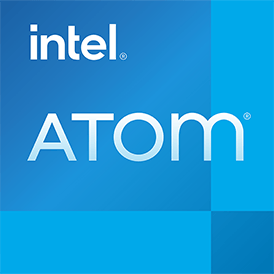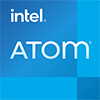
Intel Atom

Actual generation: 7.
Actual architecture: Alder Lake N
Technology: 10 nm
Chip design: Monolithic
Instruction set: SSE4.1, SSE4.2, AVX2
Virtualization: VT-x, VT-x EPT, VT-d
Intel Atom processors are very economical processors that are used in netbooks, smaller notebooks and mini servers. Atom processors starting with an E are intended for private use and have an internal graphics card. They have 1-4 physical cores and mostly support low-voltage RAM, for example LPDDR4, as well as normal modules.Actual architecture: Alder Lake N
Technology: 10 nm
Chip design: Monolithic
Instruction set: SSE4.1, SSE4.2, AVX2
Virtualization: VT-x, VT-x EPT, VT-d
The new Atom C series, on the other hand, is intended for use in mini servers or web servers. Intel Atom C processors can provide up to 8 physical CPU cores, but like the E series for private use, all Intel Atom processors do not have these Hyper-Threading Technology. The fastest 8-core Intel Atom C2750 should be about half as fast as an Intel Xeon 1220 v3 with a quarter of the energy consumption.
For the first time, the Intel Atom C series supports up to 4 modules with 16GB each, i.e. a total of 64GB DDR3-1333 RAM, which results in a memory bandwidth of 25.3GB/s. Intel Atom processors are often advertised with a maximum RAM support of only 8 GB. In reality, however, these systems can also get by with 16 GB, sometimes even 32 GB of RAM. However, since the Intel Atom processors form the entry-level segment of Intel processors, the official amount of main memory is usually reported as low on purpose.
Contrary to Intel Celeron and Intel Pentium processors, which are mostly based on the current Intel Core i series, the Intel Atom processors are independent developments. These are characterized by an even better energy consumption and the capability also in systems that are passively cooled (i.e. without a CPU fan and only with a heat sink). Modern Intel Atom processors do not have to be slow and are usually also suitable for office PCs and NAS systems.
All Intel Atom CPUs
| Processor | Generation | ||
 |
Intel Atom x7835RE 8C 8T @ 1.30 GHz |
7. | |
 |
Intel Atom x7809C 8C 8T @ 2.40 GHz |
7. | |
 |
Intel Atom x7433RE 4C 4T @ 1.50 GHz |
7. | |
 |
Intel Atom x7425E 4C 4T @ 1.50 GHz |
7. | |
 |
Intel Atom x7405C 4C 4T @ 2.20 GHz |
7. | |
 |
Intel Atom x7213RE 2C 2T @ 2.00 GHz |
7. | |
 |
Intel Atom x7213E 2C 2T @ 1.00 GHz |
7. | |
 |
Intel Atom x7211RE 2C 2T @ 1.00 GHz |
7. | |
 |
Intel Atom x7211E 2C 2T @ 1.00 GHz |
7. | |
 |
Intel Atom x7203C 2C 2T @ 2.00 GHz |
7. | |
 |
Intel Atom x6427FE 4C 4T @ 1.90 GHz |
6. | |
 |
Intel Atom x6425RE 4C 4T @ 1.90 GHz |
6. | |
 |
Intel Atom x6425E 4C 4T @ 2.00 GHz |
6. | |
 |
Intel Atom x6416RE 4C 4T @ 1.70 GHz |
6. | |
 |
Intel Atom x6414RE 4C 4T @ 1.50 GHz |
6. | |
 |
Intel Atom x6413E 4C 4T @ 1.50 GHz |
6. | |
 |
Intel Atom x6214RE 2C 2T @ 1.40 GHz |
6. | |
 |
Intel Atom x6212RE 2C 2T @ 1.20 GHz |
6. | |
 |
Intel Atom x6211E 2C 2T @ 1.30 GHz |
6. | |
 |
Intel Atom x6200FE 2C 2T @ 1.00 GHz |
6. |
Intel Atom generation list
| Name | Generation | Segment | Technology | Architecture |
| Intel Atom x7000 | 7. | Mobile | 10 nm | Alder Lake N |
| Intel Atom x7000 AL | 7. | Mobile | 10 nm | Amston Lake |
| Intel Atom C5000 | 6. | Desktop / Server | 10 nm | Parker Ridge |
| Intel Atom x6000 | 6. | Mobile | 10 nm | Elkhart Lake |
| Intel Atom C3000 | 5. | Desktop / Server | 14 nm | Denverton |
| Intel Atom x3/x5/x7 | 5. | Mobile | 14 nm | Cherry Trail |
| Intel Atom Z3500 | 5. | Mobile | 22 nm | Moorefield |
| Intel Atom E3800 | 4. | Mobile | 22 nm | Bay Trail |
| Intel Atom Z3700 | 4. | Mobile | 22 nm | Bay Trail |
| Intel Atom C2000 | 3. | Desktop / Server | 22 nm | Avoton |
| Intel Atom Z3400 | 3. | Mobile | 22 nm | Merrifield |
| Intel Atom CE5300 | 3. | Mobile | 32 nm | Berryville |
| Intel Atom N2000 | 3. | Desktop / Server | 32 nm | Cedarview |
| Intel Atom Z2400/Z2600 | 3. | Mobile | 32 nm | Penwell |
| Intel Atom S1000 | 2. | Desktop / Server | 32 nm | Centerton |
| Intel Atom Z2500/Z2700 | 2. | Mobile | 32 nm | Cloverview |
| Intel Atom N400/N500 | 2. | Desktop / Server | 45 nm | Pineview |
| Intel Atom D2000 | 1. | Desktop / Server | 32 nm | Cedarview |
| Intel Atom Z500 | 1. | Mobile | 45 nm | Silverthorne |
back to index



